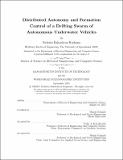| dc.contributor.advisor | Henrik Schmidt. | en_US |
| dc.contributor.author | Rypkema, Nicholas Rahardiyan | en_US |
| dc.contributor.other | Woods Hole Oceanographic Institution. | en_US |
| dc.date.accessioned | 2016-03-03T20:30:44Z | |
| dc.date.available | 2016-03-03T20:30:44Z | |
| dc.date.copyright | 2015 | en_US |
| dc.date.issued | 2015 | en_US |
| dc.identifier.uri | http://hdl.handle.net/1721.1/101474 | |
| dc.description | Thesis: S.M., Joint Program in Applied Ocean Science and Engineering (Massachusetts Institute of Technology, Department of Electrical Engineering and Computer Science; and the Woods Hole Oceanographic Institution), 2015. | en_US |
| dc.description | This electronic version was submitted by the student author. The certified thesis is available in the Institute Archives and Special Collections. | en_US |
| dc.description | Cataloged from student-submitted PDF version of thesis. | en_US |
| dc.description | Includes bibliographical references (pages 163-168). | en_US |
| dc.description.abstract | Recent advances in autonomous underwater vehicle (AUV) technology have led to their wide- spread acceptance and adoption for use in scientific, commercial, and defence applications in the underwater domain. At the same time, research progress in swarm robotics has seen swarm intelligence algorithms in use with greater eect on real-world robots in the field. A group of AUVs utilizing swarm intelligence concepts has the potential to address issues more effectively than a single AUV, and such a group can potentially open up new areas of application. Examples include the monitoring and tracking of highly dynamic oceanographic phenomena such as phytoplankton blooms and the use of an AUV swarm as a virtual acoustic receiver for sea-bottom seismic surveying or the monitoring of naturally occurring acoustic radiation from cracking ice. However, the limitations of the undersea environment places unique constraints on the use of existing swarm robotics approaches with AUVs. In particular, algorithms must be distributed and robust in the face of localization error and degraded communications. This work presents an investigation into one particular swarm strategy for a group of AUVs, termed formation control, with consideration to the constraints of the underwater domain. Four formation control algorithms, each developed and tested within the MOOS-IvP framework, are presented. In addition, a 'formation quality' metric is introduced. This metric is used in conjunction with a measure of formation energy expenditure to compare the efficacy of each behaviour during construction of a desired formation, and formation maintenance while it drifts in ocean currents. This metric is also used to compare robustness of each algorithm in the presence of vehicle failure and changing communication rate. | en_US |
| dc.description.statementofresponsibility | by Nicholas Rahardiyan Rypkema. | en_US |
| dc.format.extent | 168 pages | en_US |
| dc.language.iso | eng | en_US |
| dc.publisher | Massachusetts Institute of Technology | en_US |
| dc.rights | M.I.T. theses are protected by copyright. They may be viewed from this source for any purpose, but reproduction or distribution in any format is prohibited without written permission. See provided URL for inquiries about permission. | en_US |
| dc.rights.uri | http://dspace.mit.edu/handle/1721.1/7582 | en_US |
| dc.subject | Joint Program in Applied Ocean Science and Engineering. | en_US |
| dc.subject | Electrical Engineering and Computer Science. | en_US |
| dc.subject | Woods Hole Oceanographic Institution. | en_US |
| dc.subject.lcsh | Computer networks | en_US |
| dc.title | Distributed autonomy and formation control of a drifting swarm of autonomous underwater vehicles | en_US |
| dc.type | Thesis | en_US |
| dc.description.degree | S.M. | en_US |
| dc.contributor.department | Joint Program in Applied Ocean Physics and Engineering | en_US |
| dc.contributor.department | Woods Hole Oceanographic Institution | en_US |
| dc.contributor.department | Massachusetts Institute of Technology. Department of Electrical Engineering and Computer Science | |
| dc.identifier.oclc | 940975002 | en_US |
